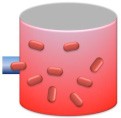Modelling of bacteria sheds light on drug-resistance

Researchers from the Institute for Condensed Matter & Complex Systems have published a paper in Physical Review Letters which sheds light on how bacteria can become resistant to antibiotics very rapidly in some environments, but not in others.
The emergence of disease-causing bacteria which are resistant to known antibiotics is one of the most important current global health challenges. Drug-resistant "superbugs" kill thousands of people in the UK every year. This is a growing problem, because new antibiotics are not being discovered fast enough to keep up with the rate of evolution of resistance.
Theoretical model
Using a simple theoretical model of a bacterial population which expands to colonize a new territory, Philip Greulich, Bartlomiej Waclaw and Rosalind Allen show that a non-uniform concentration of antibiotic can greatly speed up the evolution of resistance, compared to the case where the drug is evenly distributed. Non-uniform drug distributions are expected to be very common: for example, drugs in our body accumulate to different levels in different organs. Importantly, the speedup in evolution of resistance that is predicted by the model depends on the sequence of genetic mutations by which the bacteria become drug resistant. It only happens if all the mutations along the pathway increase the drug resistance. Unfortunately, this seems to be the case for many commonly-used antibiotics.
This research shows that simple, statistical physics models can provide important insights into biological problems. The theory developed by the Edinburgh researchers may also be relevant to the evolution of cancer cells resistant to chemotherapeutic drugs, suggesting that the highly non-uniform microenvironments found inside tumours may present a major obstacle to the successful treatment of the tumour before drug resistance emerges.

